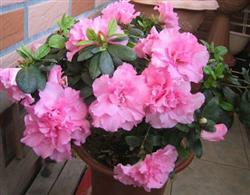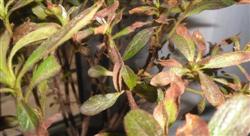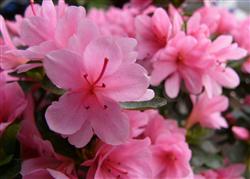Why did the azaleas die?

Why did the azaleas die? Please introduce the prevention and control methods of rhododendron with beautiful shape and colorful flowers. It is one of the top ten traditional flowers in China. It is a common flower for landscaping, indoor potted plants and bonsai production. There are many reasons for the shedding or death of rhododendron buds, mainly as follows: rhododendron is suitable to grow in acidic sandy soil rich in humus, strong permeability and pH 5.0 to 6.5, and avoid alkaline soil and clayey soil. The planting land is alkaline or viscous and the air permeability is not strong, which can easily lead to poor plant growth, bud shedding and even death. If the concentration of fertilizer is too high or the raw fertilizer is not mature, it will cause "root burning", resulting in bud drop and plant death. Watered cuckoo roots are very slender, afraid of waterlogging. Too much watering can lead to lack of air in the soil, resulting in falling buds, fallen leaves and plant death. The optimum growth temperature of rhododendron is from 12 ℃ to 25 ℃. It is easy to be hurt if it is lower than 5 ℃ or higher than 35 ℃. There are many diseases and insects harmful to rhododendron, such as leaf swelling disease, crown net bug, short beard mite and so on. Do not change the basin for many years, the plant is lack of nutrition; the time of changing the basin is inappropriate, such as severe cold in winter, blooming in spring or high temperature in summer; improper preparation of basin soil, high alkalinity, poor permeability, etc., will cause bud drop and plant death. In view of the above reasons, the following technical measures should be taken. The soil is planted in a soil that is acidic, well drained and rich in humus. If the soil is slightly alkaline, it can be improved: apply 1000 to 1200 kilograms of mature farm manure (such as pig manure and cow manure) per mu, turn it into the sun, and after a year, the alkali in the soil will be neutralized by fertilizer containing a lot of humic acid. The soil with heavy viscosity and poor air permeability can be solved by mixing river sand or sawdust, burying green fertilizer, applying organic fertilizer and so on. When potted, the cultivation substrate can be prepared with 45% rotten leaf soil, 45% peat soil, 5% sawdust, 5% bone meal or rotten cake fertilizer. Fertilized cuckoo perennial green branches and green leaves, flowers in full bloom, nutrient consumption, so the amount of fertilizer is also large. However, in order to prevent "burning roots", we must apply mature thin fertilizer according to the principle of "applying thin fertilizer frequently". In early winter, the application of 500 to 700 kg of mature farm manure per mu as base fertilizer can increase the soil temperature, benefit the growth of rhododendron in winter and enhance the ability of cold resistance and overwintering. In February before blooming in spring, the thin fertilizer of phosphate fertilizer and the combination of nitrogen and phosphorus was applied once or twice to make the azaleas green. After flower fade, liquid fertilizer based on nitrogen fertilizer was applied for 2 to 3 times, each time at an interval of 10 days, to promote more new branches and leaves. During the period of flower bud differentiation, the mature cake fertilizer was applied once, and then an appropriate amount of potassium dihydrogen phosphate was added to promote the flower bud differentiation and bud gestation. In order to maintain the acidity of the basin soil, 0.2% ferrous phosphate solution can be poured every 1 to 2 months. The root system of the watered cuckoo is a slender root group with shallow roots, which is afraid of both drought and waterlogging. Therefore, watering must be appropriate and the planting land should always be kept in a semi-wet state. Water should be watered in case of drought and drainage in case of waterlogging. Spring buds and flowering period, large water demand, watering 2 to 3 times a week to meet the needs of growth and flowering, can effectively prevent the wilting of leaves and shoots, shortening of flowering period, early flower fade and so on. The temperature is high in summer, the water evaporates quickly, and it is in the vigorous growth period of rhododendron branches and leaves, so the water demand is greater. In addition to watering water every morning and evening, it is also necessary to spray water on the leaf surface and around the flowerpot to improve the air humidity. Watering less in autumn and winter, just keep the basin soil slightly wet. Whenever there is stagnant water in the planting basin, it should be dumped in time and loosen the soil to dry. If waterlogging is particularly serious, it is necessary to turn over the basin and change the soil. Rhododendron has strong negative tolerance, so it is suitable to grow in semi-shade environment and can not stand the strong light in summer. Therefore, when choosing the planting site, it is appropriate to choose shady, moist, scattered light places under big trees. If it is a potted plant, the potted flowers should be placed under a big tree in summer to avoid bright light. Potted rhododendron must turn the pot and change soil every 1 to 2 years because of its developed root system, strong germination ability, large flowering quantity and high nutrition consumption. The preparation of pot soil should be carried out according to the method introduced in the first article above, and the specific time of basin change should be after flowering in spring or before budding in autumn. The method of operation is as follows: pour water once 1 to 2 days before turning the basin to make the basin soil expand and loose; when the pot soil is slightly dry, first pat around the flowerpot with hands to separate the pot soil from the basin wall; pry the soil in the pot with bamboo sticks or other sharp objects and gently raise the plant; remove the outer soil and topsoil of the root system, leaving only 1 canopy 3 of the old soil; cut off the rotten root, injured root, overgrown root and thin and weak root; change the larger pot and reload the soil. Pour water again and keep it in a semi-shady place. Click to get more azaleas planting techniques click to get more flower planting techniques
- Prev

How to prevent and cure leaf spot of rhododendron?
How to prevent and cure leaf spot of rhododendron? Please introduce the rhododendron tree brown spot: at the initial stage of the disease, the leaf edge produces brown spots, the disease-health junction is not obvious, showing light green? Brown? Rust-red transition, with the spread of the disease, the disease spot expands or the whole leaf turns brown, causing the leaf to fall off ahead of time, even the whole plant.
- Next

How to raise azaleas to blossom more?
How to raise azaleas to blossom more? Please introduce the delicate and beautiful azaleas you want to bloom. First of all, you should be familiar with the soil in which azaleas grow. The pH value is between 5.5 and 6.5. Do not use alkaline or clayey soil. The suitable growth temperature is 12 ℃ to 25 ℃, shade and sunscreen in summer and frost protection in winter. It is best to move indoors. Press.
Related
- Fuxing push coffee new agricultural production and marketing class: lack of small-scale processing plants
- Jujube rice field leisure farm deep ploughing Yilan for five years to create a space for organic food and play
- Nongyu Farm-A trial of organic papaya for brave women with advanced technology
- Four points for attention in the prevention and control of diseases and insect pests of edible fungi
- How to add nutrient solution to Edible Fungi
- Is there any good way to control edible fungus mites?
- Open Inoculation Technology of Edible Fungi
- Is there any clever way to use fertilizer for edible fungus in winter?
- What agents are used to kill the pathogens of edible fungi in the mushroom shed?
- Rapid drying of Edible Fungi

